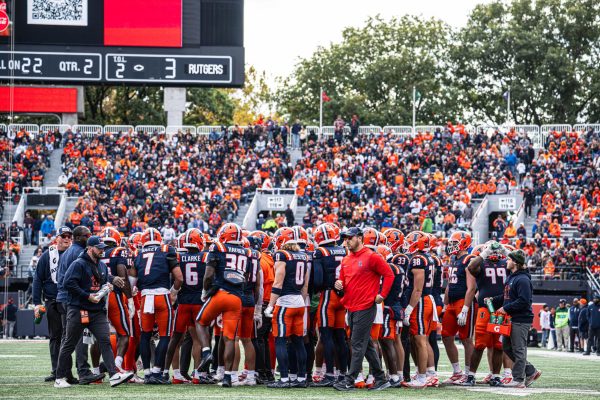UI advancements change the purpose of virtual reality
Mar 9, 2022
Virtual Reality headsets have long been associated with science fiction movies and niche tech experiences.
But during the late 2010s, VR materialized into the mainstream at lightning speed and became a popular medium for gaming. Now, the Oculus Quest is a household name at the top of Christmas lists and is available in GameStop stores nationwide.
Brenna Faber, junior in LAS, is one of many Oculus Quest users who enjoys various games on the platform such as “Beat Saber,” “Job Simulator” and “VR Chat.”
“I do find VR fun,” Faber said. “Though where it’s at now is a bit more novel than practical. I’ve really loved games like ‘Beat Saber’ and ‘SUPERHOT’ that are polished and follow your actual body’s movement to play.”
However, Faber believes that VR is just for entertainment and not destined for more.
Get The Daily Illini in your inbox!
“Right now it’s not accessible to so many people, difficult to use for people without experience in technology and not practical to use for long periods at a time,” Faber said. “I think the idea of a societal shift to virtual reality is more science fiction than a practical future.”
However, various professors and faculty members from on-campus tech initiatives believe that VR is capable of much more than just gaming. The University has made strides in VR technology integration and innovation on campus.
VR@Illinois is a focal point of the technology’s integration on campus. The collaborative initiative is a support management system for VR tech at the University that is used for teaching, research and exploration purposes.
Backed by the University’s Technology Services department, VR@Illinois coordinates with members from the Center for Innovation in Teaching & Learning, University Library’s IDEA Lab and Media Commons.
Eric Kurt, Media Commons coordinator and one of the founders of VR@Illinois, described his optimism for the use of VR in more than just gaming activities.
“VR absolutely is capable of more than gaming,” Kurt said. “Practical applications especially as it applies to education are one of the directives of VR@Illinois and we have found many great ideas. I believe that the metaverse is a very viable idea especially as VR evolves into AR.”
Elisandro Cabada, director of the Grainger Engineering Library IDEA Lab, discussed how VR endeavors in gaming have laid the groundwork for more educational routes that the University is leaning into.
“While the gaming industry is what helped establish VR as a viable commercial technology, we are seeing more and more interest in using the technology in research and course content,” Cabana said.
The IDEA Lab developed a virtual classroom platform, Project Komodo, to help facilitate educational VR experiences that are versatile and customizable. The platform is being used in a Materials Science & Engineering course and a Fashion Design course.
“VR lets you go beyond the classroom experience by letting you create discipline-specific simulations with almost infinite amounts of possibilities,” Cabana said.
Areas of health care at the Unviersity have also begun to experiment with VR.
Harris Junaid Nisar, a simulation engineer at the Healthcare Engineering Systems Center, has worked with a team of specialists to develop simulations to train medical professionals and patients using VR.
“I utilize the VR technology to recreate scenarios and interactions and guide the learner through them,” Nisar said. “I can provide more detail, screenshots or videos on projects if needed.”
While Nisar said that VR is more than gaming, he was quick to point out how using the technology for gaming isn’t completely valueless.
“Gamification of these complex scenarios can lead to more engaging training modules that don’t feel like you’re training at all,” Nisar said. “In addition, because of the immersive nature of VR, the learner must focus as there are no distractions when the headset comes on and people can get through more content in less time.”
Sarita Vikram Adve, a professor in computer science, explained how the University is now looking into extended reality initiatives. Adve is also involved in the Illinois eXtended Reality testbed Consortium. The ILLIXR aims to understand and apply extended reality tech.
“We should consider the full set of related immersive technologies when asking this question,” Adve said. “Not just virtual reality, but also augmented reality and mixed reality, all collectively referred to as extended reality. XR promises to be the next interface to computing and has the potential to transform virtually all aspects of our lives.”
Adve, while cautious about privacy matters within expanding VR technology, also wants the technology to be accessible.
“An important concern is security and privacy,” Adve said. “It also requires us as a society to grapple with what’s appropriate behavior in the virtual world and how to protect our privacy given we will be wearing glasses with cameras that are potentially always on in our homes and everywhere we go and in constant touch with the cloud.
“We also want to ensure that the technology is freely available and does not become the property of a handful of companies.”






